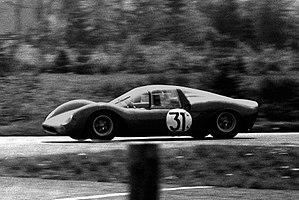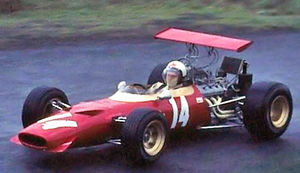Ferrari Dino

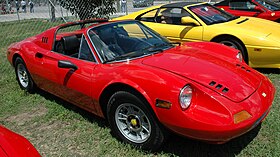
| |
| Ferrari Dino | |
|---|---|
| Manufacturer: | Ferrari |
| Class: | mid-engined sports car |
| Production: | 1968 — 1973 3,913 produced |
| Predecessor: | Fiat Dino |
| Successor: | Ferrari 308 GTB |
| Dino 206 | |
| Production: | 1968 — 1969 |
| Body Styles: | Berlinetta |
| Engines: | 2.0 L V6 |
| Dino 246 | |
| Production: | 1969 — 1973 |
| Body Styles: | Berlinetta |
| Engines: | 2.4 L V6 |
The Dino was a brand for mid-engined, rear-drive sports cars produced by Ferrari from 1968 to 1976. The Dino name was retired by 1976, though the cars remained in production. It was created as an attempt to produce a relatively low cost vehicle by using components from more common vehicles, in much the same way that Porsche did with the 914.
The Dino was the first Ferrari model produced in high numbers: Just under 4,000 V6 Dinos were built in five years. Although not universally embraced, the V6 Dinos are lauded by many for their intrinsic driving qualities and groundbreaking design. In 2004, Sports Car International named this car number six on the list of Top Sports Cars of the 1970s. Motor Trend Classic named the 206/246 as number seven in their list of the 10 "Greatest Ferraris of all time".
History
The name "Dino" honors the founder's late son, Alfredo "Dino" Ferrari, who was credited with the design of the V6 engine. Along with famed engineer, Vittorio Jano, Dino influenced Enzo Ferrari's decision to produce a line of racing cars in the 1950s, with V6 and V8 engine designs. History shows that Alfredo Ferrari did not have a hand in the actual design of the V6 motor that made its way into the Dino.
The "Dino" brand was created to market a lower priced, "affordable" sports car. The first brochure described the Dino as "almost a Ferrari". Ferrari intended to do battle in the marketplace with Porsche and its 911. The more expensive road going Ferrari V12's of the time were no match at their much higher price point. But Enzo did not want to diminish the Ferrari brand with a cheaper car, and so "Dino" was born.
In addition to being a lower priced, "affordable" sports car, it was a car built in Alfredo's honor after he lost his battle with muscular dystrophy. While in hospital, he discussed technical details with the engineer Vittorio Jano. Dino would never see the engine; he died on June 30, 1956 at the age of only 24, before his namesake automobiles Fiat Dino and Dino were produced.
In 1966 Ferrari wished to race in the 1.6 L class of the Formula 2 racing series with Dino's V6. However, the company could not meet the homologation rules which called for 500 production vehicles using the engine. Enzo Ferrari asked Fiat to co-produce a sports car using the engine, and the front-engined, rear-drive Fiat Dino was born. It used a 2.0 L (1987 cc) version of the Dino V6, allowing Ferrari to enter the series.
At the time, the thought of using a mid-engine layout in a production car was quite daring, although the design was common in the world of sports car racing. A mid-engined layout placed more of the car's weight over the driven wheels, and allowed for a streamlined nose, but led to a cramped passenger compartment and more challenging handling. Lamborghini created a stir in 1966 with its mid-engined Miura, but Enzo Ferrari felt that a mid-engine Ferrari would be unsafe in the hands of his customers. Eventually he relented, and allowed designer Sergio Pininfarina to build a mid-engined concept for the 1965 Paris Motor Show, but demanded that it wear the Dino badge alone. The 1966 Turin car show featured a refined Dino 206S. The Turin 206S was a closer prototype to the actual production version. Response to the radically-styled car was positive, so Ferrari allowed it to go into production, rationalizing that the low-power V6 engine would keep his customers out of trouble.
Dino 206 GT
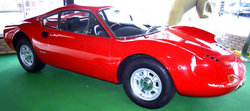
| |
| Dino 206 GT | |
|---|---|
| Production | 1968–1969 152 produced |
| Engine | 2.0 L V6 |
The production Dino 206 GT had the soft edges and curving lines typical of earlier Italian cars, unlike its successor, the Bertone designed 308 GT4, which has the straighter lines and crisp edges seen most boldly in Bertone's later Fiat X1/9.
The 206 GT used a transverse-mounted 2.0 L all-aluminum, 160hp @ 8000 rpm redline, 65 degree V6 engine, Dual overhead camshafts, 9.7:1 Compression ratio. Torque was 138 pounds*foot @ 6500 rpm. The crankshaft featured four main bearings. Induction was via three Weber 40 DCN/4 2-barrel carburetors.
The 206 GT frame featured a light-weight, 1980 pound, aluminum body, full independent suspension, and all round disc brakes. The 206 GT had a 90.0in wheelbase.
The 206 had a top speed of 146mi/h.
152 were built in total during 1968 and 1969, all were right-hand drive (left-hand traffic). (I do not think this is correct. All I can find are LHD cars. Has the photo on this page been revised giving the impression of a RHD car? The alternative explanation is that both LHD and RHD cars were produced, but what is the truth of the matter?)
The same 2.0L engine was used in the Fiat Dino Coupe and Spider, produced during the same period. The conversion of the Dino 196 racing engine for road-going use in the Dino (and the two Fiat models) was entrusted by Fiat to Aurelio Lampredi, to whom Ferrari owed so many great engines. Lampredi, interviewed in the early 1980s (he died in 1989 at the age of 72), noted that, "Things didn't work out exactly as Ferrari had foreseen." Ferrari had counted building the engines at Maranello, but Fiat's management insisted on taking control of production, to avoid any breaks in the engine supply.
Fiat quoted 160 hp DIN for the Fiat Dino and Coupe, and in 1967 Ferrari - presenting the first prototype of the Dino 206 GT - claimed 180 hp. This, however, was not the case. Both engines were made by Fiat workers in Turin on the same production line, without any discrimination as to their destination, and all were exactly the same. 150 units were simply taken from the first production batch at the beginning of 1968 to power the Dino 206 GTs. Jean-Pierre Gabriel, writing in "Les Ferraris de Turin", notes that, "La declaration de Ferrari ne reposait sur aucun fondament technique" - Ferrari's statement had no technical basis! However, as always, it was certainly a savvy piece of marketing by the Commendatore.
Later Fiat Dinos also used the 2.4L engine, although significantly fewer were produced with this motor.
Dino 246 GT & GTS
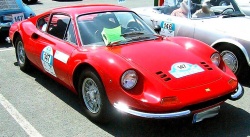
| |
| Ferrari Dino 246 GT & GTS | |
|---|---|
| Manufacturer | Ferrari |
| Parent company | Fiat Group |
| Class | Sports car |
| Layout | MR layout |
| Engine | 2.4 L V6 |
| Production | 1969–1974 3,761 produced |
| Body style | Berlinetta Targa top |
| Successor | Ferrari 308 |
| Related | Fiat Dino |
Calls for more power were answered with the 2.4 L (2418 cc) Dino 246. The motor was a 65 degree, dual overhead camshaft, 9.0:1 compression ratio, iron block with alloy heads. The European motor produced 195 bhp (at 7,600 rpm), and was available as a fixed-top GT coupe or, after 1971, an open Spyder GTS. The American version had an exhaust air-pump, and timing changes which created 175hp. The GT had 3 Weber 40 DCNF/6 or 40 DCNF/7 carburetors.
The 246 Dino GT weighed 2380 pounds. The 246 Dino GTS weighed 2426 pounds. The body was now made of steel to save cost. The 246 Dino had a 2.1in longer wheelbase than the 206, at 92.1 inches. The height of the 246 was the same as the 206 at 43.9 inches.
Production numbered 2,487 GTs and 1,274 Spyders, the latter being built from 1972 to 1974 only, for a total production run of 3,761.
The 246 had a top speed of 146mi/h.
The Dino's 2.4L V6 found its way into a number of other Italian performance cars after its application in the 246, most notably the Lancia Stratos rally car.
Dino 308 GT4
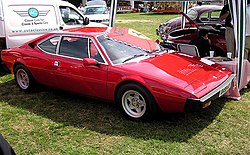
| |
| Dino 308 GT4 2+2 | |
|---|---|
| Successor | Ferrari 208/308 GT4 |
| Production | 1973–1976 (branded as Dino) |
| Body style | 2+2 Coupe |
| Engine | 3.0 L V8 |
Main article: Ferrari GT4
The 308 GT4 was produced from 1973 to April 1980. Initially branded "Dino", the 308 GT4 was Ferrari's first V-8 production automobile.
The 308 had a wheelbase of 100.4in. The 308 was designed by Bertone, looking quite differently from the 206/246 from which it was derived.
The 308 GT4 V-8 had a 90 degree, dual over head camshaft, 2927 cc motor with 4 Weber carburetors which produced 250hp. The V-8 block and heads were made of an aluminum alloy. The compression ratio was 8.8:1. The American version had a timing change and an air-pump which produced a modest 230hp. The GT4 weighed 2535 pounds.
The angular or "wedge-shaped" Bertone-styled 2+2 308 GT4 wore the Dino badge until May 1976, when it finally got the Ferrari "Prancing Horse" badge on the hood, wheels, and the steering wheel.
| < Ferrari timeline 1948–1967 | Ferrari timeline 1960s-1990s | Ferrari timeline 1990–Present > | |||||||||||||||||||||||||||||||||||||||
| Type | 1960s | 1970s | 1980s | 1990s | |||||||||||||||||||||||||||||||||||||
| 0 | 1 | 2 | 3 | 4 | 5 | 6 | 7 | 8 | 9 | 0 | 1 | 2 | 3 | 4 | 5 | 6 | 7 | 8 | 9 | 0 | 1 | 2 | 3 | 4 | 5 | 6 | 7 | 8 | 9 | 0 | 1 | 2 | 3 | 4 | 5 | 6 | 7 | 8 | 9 | ||
| 8 cylinder | Mid-engine berlinetta | 308 | 308 i | 308 QV | 328 | 348 | 360 | ||||||||||||||||||||||||||||||||||
| 208 | 208 Turbo | GTB/GTS Turbo | F355 | ||||||||||||||||||||||||||||||||||||||
| Mid-engine 2+2 | 308 GT4 | Mondial 8 | Mondial QV | Mondial 3.2 | Mondial t | ||||||||||||||||||||||||||||||||||||
| 208 GT4 | |||||||||||||||||||||||||||||||||||||||||
| 12 cylinder | Boxer berlinetta | 365 BB | 512 BB | 512i BB | Testarossa | 512TR | F512M | ||||||||||||||||||||||||||||||||||
| Grand tourer | 250 | 275 | 365 GTB/4 "Daytona" |
550 Maranello | |||||||||||||||||||||||||||||||||||||
| America | 330 | 365 | |||||||||||||||||||||||||||||||||||||||
| 2+2 coupé | 250 GT/E | 330 GT 2+2 | 365 GT 2+2 | 365GTC/4 | GT4 2+2 | 400 | 400 i | 412 | 456 | 456 M | |||||||||||||||||||||||||||||||
| Supercar | 250 GTO | 250 LM | 288 GTO |
F40 | F50 | ||||||||||||||||||||||||||||||||||||
| Sold under the Dino marque until 1976; see also Ferrari Dino | |||||||||||||||||||||||||||||||||||||||||
